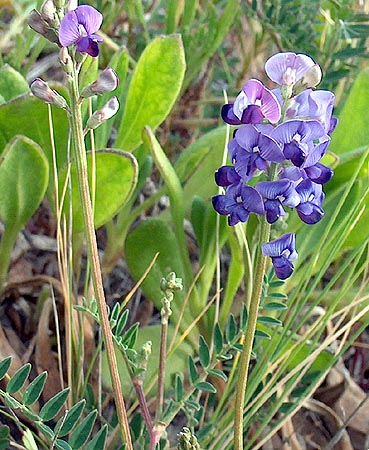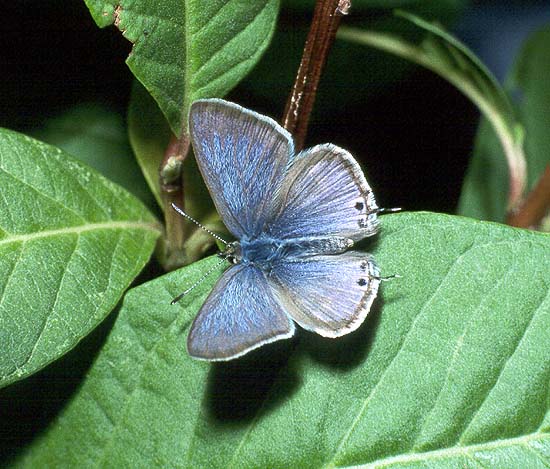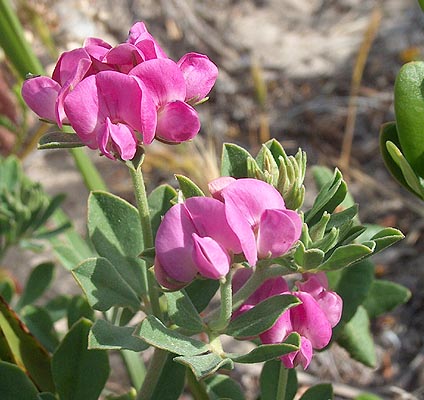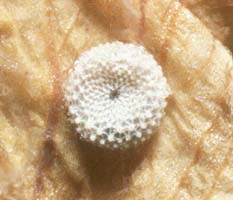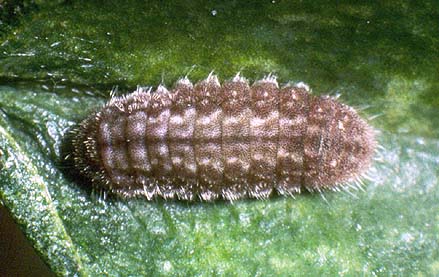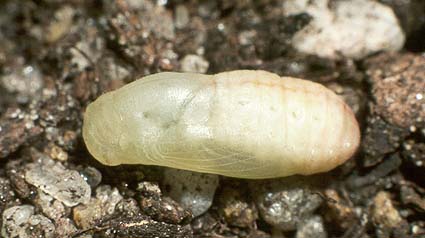-
Larval Food Host
-
Larvae feed on numerous native and introduced legumes of the Fabaceae family including
*Chamaecytisus palmensis (tree lucerne or tagasaste),
*Colutea arborescens (bladder senna),
Crotalaria spp incl. C. cunninghamii (birdflower rattlepod),
C. eremaea eremaea (downy loose-flowered rattle-pod),
C. eremaea strehlowii (smooth loose-flowered rattlepod),
C. novae-hollandiae (woolly rattlepod),
Cullen (Psoralea) australasicum (tall scurf-pea),
C. patens (spreading scurf-pea),
*Cytisus scoparius (English Broom),
*Dipogon lignosus (lavatory creeper or dolichos pea),
*Genista monspessulana (Montpellier Broom),
Gompholobium ecostatum (dwarf wedge-pea),
Kennedia prostrata (running postman or scarlet runner),
Indigofera sp (indigo), *Lathyrus odoratus (sweet-pea),
Lotus australis (austral trefoil),
*Lupinus spp (lupins), *Phaseolus vulgaris (garden bean),
*P. lunatus, *Pisum sativum (garden pea),
Pultenaea tenuifolia (narrow-leaf bush-pea),
Sesbania cannabina (sesbania pea), *Sophora spp,
Swainsona spp (darling or swainson peas) incl.
S. (Clianthus) formosa (Sturt's desert-pea),
S. greyana (darling pea), S. stipularis (orange darling pea),
Templetonia retusa (cockies tongue), *Ulex europaeus (gorse),
*Vicia faba (broadbean), *V. sativa (common vetch),
*Virgilia oroboides (Cape virgilia), *Wisteria sinensis.
The larvae prefer to eat the inner ovary and stamen parts of buds and flowers,
and the immature seeds within developing seed pods.
The use of these hostplants depends on the local butterfly population, which preferentially
use certain hostplants, possibly due to whether the flowering coincides with the flight of
the butterfly. For example the butterfly will utilise broom in Victoria and gorse in New
Zealand, but has not been seen to use these plants in South Australia.
-
Larval Attendant Ant
-
Larvae are sometimes attended by a few ants, including the large
Camponotus sugar ants (subnitidus
and tricoloratus groups, and in the Far North by a large
black sugar-ant Camponotus capito), and
Iridomyrmex sp, and very rarely the large
meat ants Iridomyrmex purpureus and I. viridiaeneus.
In the eastern states, small Dolichoderus sp and
Froggattella sp are also documented. In the case of the
larger ants, it is more often a harmless association on the same
bush rather than direct attendance of the ants to the larvae.
-
Eggs
-
Small, initially pale green, later turning bluish white, hemispherical,
strongly flattened top and bottom, slightly depressed on top with a
small darker central micropylar area. Ornamented with short blunt spines
on the side, which are absent on the top of the egg. The reticulation
facets are trigonal, which are grouped together in an orderly fashion
to form large hexagons. The facets on the top of the egg are much smaller
and are of irregular shape. Laid singly on the foodplant, usually on flower
buds, but sometimes on the open flowers and softer green parts. The eggs
hatch in about seven days during spring. Eggs are sometimes so common on
the flower buds as to produce a fine speckled appearance.
-
Larvae
-
Initially pale yellow, subtranslucent, changing colour after eating the foodplant,
with sparse short dark hairs that are longer posteriorly. The prothoracic and
posterior anal plates dark coloured and well developed. The head is large, black
and exposed. This stage, although very small, is rather maggot-like in appearance.
Later instars are onisciform (slater shaped) with secondary setae and a few short
lateral hairs. Newly emerged larvae immediately bore into the flower buds to reach
and eat the inner ovary and stamen parts, and usually disappear inside the flower.
Early larval instars will continue to eat the insides of the flowers, but larger
instars will also bore into immature pods to eat the soft developing seeds.
The mature larvae are about 13-16 mm long. The head is small, smooth, brownish yellow,
hidden beneath the body. The body has some short lateral hairs, and a few subdorsal
hairs on the thoracic segments. It is covered in numerous minute secondary setae
having a stellate base and an erect serrated central spine which can be blunt or
pointed. The larvae are polymorphic (ie. they occur in many colour forms).
Larvae colour and markings are highly variable, being some shade of green, pink or
purple, or combinations thereof, with a darker longitudinal dorsal line and adjacent
forward directed chevrons, a hatchured subdorsal line, sometimes additional lateral
markings, and there is often a pale lateral line. The colours are cryptic and usually
blend in with the portion of the foodplant they are eating, such as pink or purple if
they are eating red or purple flower buds, or green or yellowish green if they are on
yellow flowers or green pods. The latter larvae are almost maggot-like in appearance.
In captivity the colour can change during the life of the larva.
Larvae feed openly during the day, but are usually hidden within the flowers or seed
pods. The presence of larvae on the foodplant are readily discernible by holes in
the buds, flowers and seed pods. These larvae, like most Lycaenid larvae are able to
considerably extend their heads and are able to eat out the seed contents of a pod by
protruding the head inside the hole made at the side of the pod, while the rest of the
body remains outside the pod.
Larvae are sometimes so prolific on the foodplant that they quickly consume all of the
edible parts. Some of these larvae are able to pupate even though not fully developed,
producing smaller than normal flying adults. While others may become cannibals, and
devour either smaller larvae, particularly those undertaking a moult, or larger larvae
undertaking pupation. Fully hardened pupae are not eaten due to their tough outer case.
This cannibal tendency occurs in many Lycaenid species, particularly those species which
lay large numbers of eggs on foodplants of small stature.
Larvae of this species often accompany those of Zizina labradus
on the same foodplant, in which case the former usually eat the flower and seed pod contents,
while the latter eat the leaves and flower petals. Under stress, the Lampides boeticus
larvae will also eat the larvae of Z. labradus.
-
Pupae
-
Short cylindrical, mostly smooth with a few short bristles near the head, rounded anteriorly
and posteriorly, about 10 mm long, polymorphic in various shades of brown, pink brown or
green brown, speckled with darker markings which are more concentrated on the thorax, head
and wings, and with a darker dorsal line and two subdorsal rows of black dots along the
abdomen, weakly attached by anal hooks and a central girdle.
When ready to pupate the larvae have a variety of methods of finding a suitable location.
Some will crawl to the base of the foodplant, or simply drop off or lower themselves by
silk from the foodplant to the ground, to look for a place to pupate. This can be among
leaf and other debris within or around the base of the plant, beneath nearby rocks, or
they can pupate in holes in the ground. In sandy country they will actually force
themselves into the loose sand to pupate if there is not enough debris about. They will
also pupate within flowers on the foodplant, so that when the flower eventually dies,
shrivels, and falls to the ground, the pupa falls hidden within it. They also sometimes
pupate inside the consumed seedpods if there is enough room. The pupation period is
variable, even within the same population. It can be as short as 10 days in summer,
extending to a month in winter. It has not been determined if the pupae can aestivate
a full year to coincide with the next season of hostplant flowering. In captivity the
pupae always mature quickly.
-
Flight Period in South Australia
-
It is possible to find flying butterflies throughout the year, depending on the area
and whether its foodplants are in flower. In the Far North pastoral areas the butterfly
is largely dependent on the rainy periods. In the southern areas of native vegetation
it is more common during the spring, while in the urban garden it can be found during
the warmer months. They are capable of completing a brood within about seven weeks in
southern areas. In the cold areas the butterflies normally overwinter as pupae.

-
Distribution
-
Occurs throughout Australia, including Kangaroo Island and Tasmania. It has migration
tendencies, which are occasionally witnessed in Australia, heading in a southerly
direction. This is supported by the adult morphology, which is uniform across Australia,
and also the rest of the Eastern Hemisphere where the butterfly also occurs. No mass
migrations have ever been reported from South Australia, although the odd spring vagrant
has been seen flying from the mainland across Backstairs Passage to Kangaroo Island.
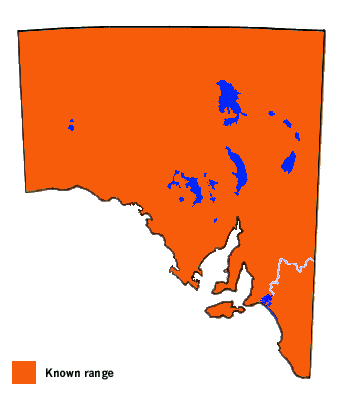
-
Habitat
-
Found wherever its foodplants occur, which are common and widespread
occurring in most habitats.
-
Conservation Status in South Australia
-
Occurs locally in breeding areas. Sometimes common in the northern pastoral areas
after rains when there may be a uniform mass blooming of its foodplants.
Rarely common in the southern areas.
-
Threats
-
No major threats.
-
Conservation Strategy
-
None required. Thrives in urban gardens. Sometimes considered a pest due to
the fondness of its larvae for low growing leguminous crops and vegetables.



